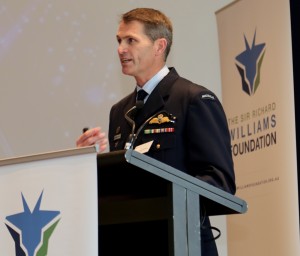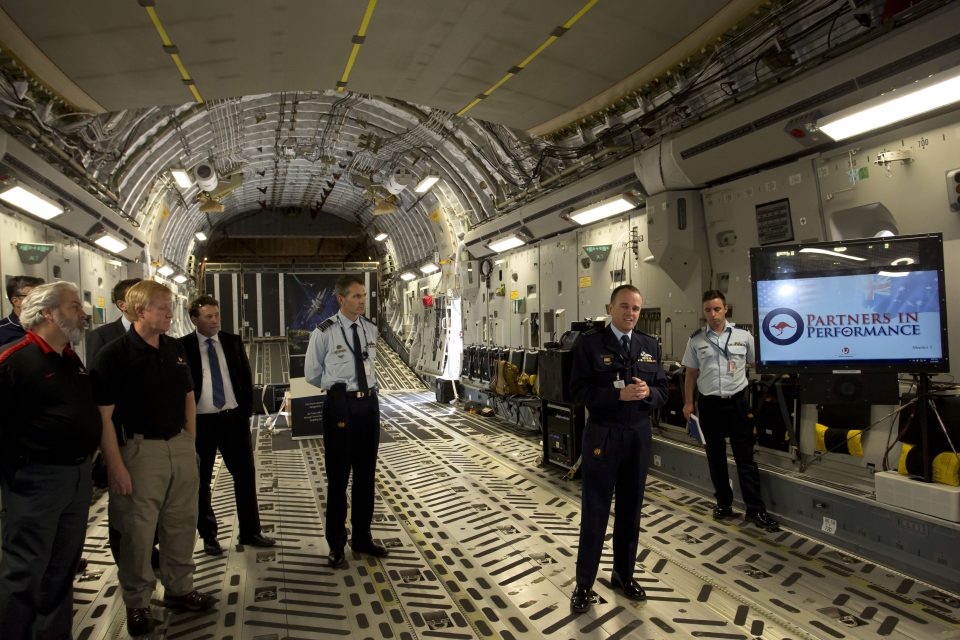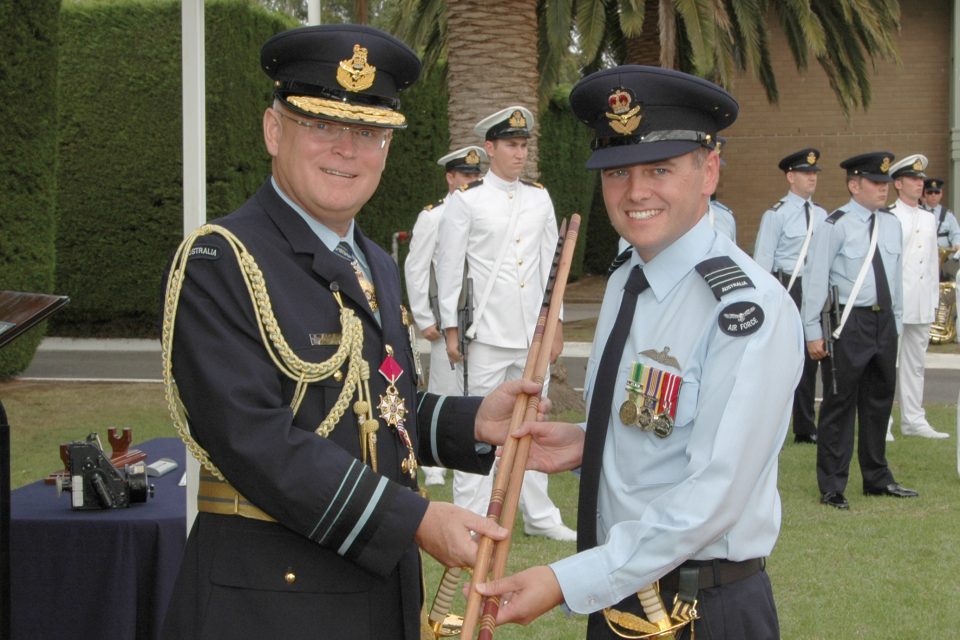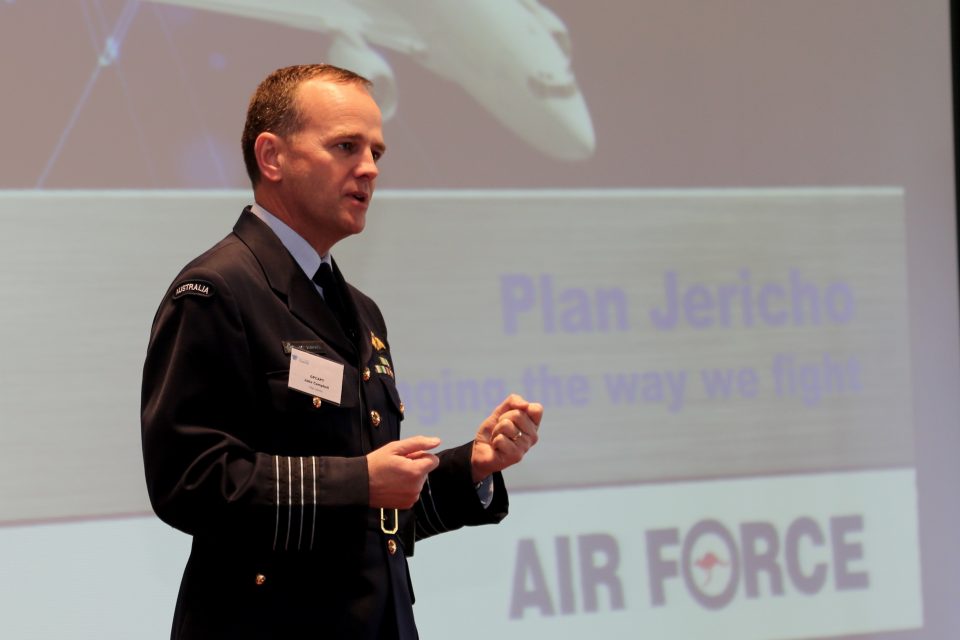2015-08-29 By Robbin Laird
Prior to the Williams Foundation Workshop on Plan Jericho, I had a chance to sit down with the two co-directors of Plan Jericho in the Royal Australian Air Force (RAAF) in their offices in the Ministry of Defence.
The co-directors led the afternoon session of the Workshop on August 6th where several RAAF officers, members of industry and other Australian services participated in the discussion of ways to shape the way ahead for Plan Jericho.
The way the project has been set up and the background of the co-directors are key elements of shaping a path to success.
Group Captain Rob Chipman is a fighter pilot with C2 experience and his last assignment was as Commander Air Task Unit 630.1 in the Middle East.
Group Captain Jake Campbell is a P-3 operator by background and has experience in the ISR and intelligence communities.
In effect, the blending of strike with situational awareness within a distributed C2 environment is one of the key targets of the Plan Jericho effort.
And reshaping the template for operations in light of the coming of the F-35 makes sense as a C2/ISR fighter comes into the force, playing a catalytic role for further change, notably in a force which is being reconfigured to a more effective 21st century combat force.
The two report directly to the two key Air Vice Marshal’s Warren McDonald and Gavin Turnbull.
As Air Vice-Marshal Warren McDonald, Deputy Chief of the Air Force, and Air Vice-Marshal Gavin Turnbull, Air Commander Australia, put it in their forward to the Plan Jericho work program:
The Royal Australian Air Force has an outstanding record of achievement across the spectrum of conflict from high-end warfighting to counter insurgency operations to humanitarian support in the wake of natural disasters. In the future, responding to global and regional events will be more difficult, as the proliferation of technology and the advancement in potential adversaries’ capabilities pose new challenges to the Australian Defence Force.
To rise to this challenge, Air Force needs to extract every last bit of mission effectiveness from our capabilities by investing in our education and training, and the development of integrated tactics and networks. Air Force must embrace innovative thinking and be prepared to rapidly harness the potential of emerging technology.
Developing an integrated, networked force will be the difference between simply owning fifth generation aircraft and being a truly fifth generation Air Force. We will work collaboratively with Navy, Army, other Defence groups and our industry partners to ensure Air Force contributes seamlessly to, and enhances, joint operational outcomes.
Plan JERICHO is the key to delivering the future force, and the enclosed Program of Work outlines the integration activities that will transform Air Force over the next ten years.
This transformation will allow us to maintain mastery of a changing air and space domain whilst remaining responsive to whatever the future may bring. All of us in Air Force, the broader Defence organization and industry will need to work together if we are to deliver this program. We look forward to the journey.
Question: How does the structure reflect the Plan Jericho Approach?
Group Captains: The concept of having two co-directors was born out of a seminar at the end of last year.
We held a workshop to understand what Jericho should be about. RAAF leadership participated and there was a clear recognition that for this to work, it could not be led by starboards in the Air Force.
The time frame for them is too short.
This has to be an enduring cultural change.
The idea was to reach further down into the organization.
And they also wanted cross-cultures in terms of the implementation of Jericho, which is why they have tasked us, one from the ISR culture and the other from the air combat culture.
The idea was to cut through the bureaucracy as well so we report directly for the Air Commander and the Deputy Chief of the Air Force.
There is no one star between us and them.
Question: What is the fifth generation mindset you are bringing to this effort?
Group Captains: For us the fifth generation mindset is one where sensor information across all our capabilities is integrated to deliver a more effective combat force.
We recognize this capability within the JSF fleet, where F-35s are able to collaborate within a formation to dramatically improve their effectiveness.
We are looking to re-shape our entire force with this mindset and create a more effective sensor enabled force which can operate in a distributed manner to deliver the desired combat effect.
We are also bringing an operational mentality to Plan Jericho.
In operations, we make changes relatively quickly, which does not happen at the program level.
We’ve got to find ways to work together. It’s not all about widgets and technology.
It can be just about working together to develop our understanding and advance combined TTPs (Tactics, Techniques and Procedures) and practice what we can do together.
And all of those things contribute to us improving our innovative war fighting effectiveness.
If we would characterize the mantra of Plan Jericho, it is about changing the way we fight.
We’re incremental, we’re about war fighting effectiveness, and we’re about changing combat approaches driven by rethinking concepts of operations.
Question: A key element of the shift is in terms of decision-making or pushing decision making to the level of activity where the decision is most appropriate. It is about shaping the commander’s intent and really unleashing the combat packages to get the job done at the forward point of operations.
How do you view this shift?
Group Captains: The shift you have described is a key one. We are doing it for two reasons.

The first is to get information to the person that needs it in the battle space and to achieve the best tactical effect.
The second is to have enhanced organizational resilience.
We want to be able to operate effectively when we lose connectivity back to mother ship.
We need to be able to get information into the battle space so that we can continue the fight no matter what the status of the network is.
This means that we need to think differently about information control in the battle space.
Question: The tanker and Wedgetail are two programs whereby you began to see the shift towards working differently with industry to get the platform into the hands of the warfighter to allow the combat driven innovation process accelerated.
How do you view these case studies, so to speak?
Group Captains: If we take the case of the tanker, we put the platform into operation prior to what was envisaged as the original IOC.
It was supposed to be able to do tanking via a boom as well as probe and drogue.
It went to the Middle East with only the later capability.
But it has made a tremendous contribution and we are now getting close to achieving operational capability with the boom as well.
The tanker experience sends a really strong message.
Part of being innovative and developing capability is getting it into the hands of the operators and working in partnership with industry to improve it.
We can’t simply wait until industry has complied with the complete list of requirements set out at the outset of the program.
In other words, we are bringing that operational mindset that we spoke about before back home. That’s really what Jericho’s about.
It’s empowering people, it’s giving them permission to innovate and I think that’s what we see working great on operations. So let’s get that mindset back home because we can’t afford the luxury of time anymore.
We don’t have ten years at home to turn out new capabilities and then deploy.
Our adversaries are not waiting until we meet the requirements list for a new program.
Question: The RAAF held a workshop to broaden understanding of Plan Jericho in the RAAF last March.
Can you describe what happened there?
Group Captains: We took representatives from all the capabilities across the air force.
It was the first time in our 25 years of service I’ve sat in a room where we’ve had people from all different capabilities talking about how we want to work together. And so that was great.
The inspiration for that came from the US.
That happens at the air warfare center every other day in the US.
And it happens in the UK at their air warfare center.
It will happen in Australia at our warfare center.
We’re also encouraging experimentation through a series of exercises called Jericho Dawn as well.
Question: Clearly, the approach requires working differently with defense industry
How do you view that change?
Group Captains: Right from the outset we need to have a better discussion with industry at the needs phase in the capability acquisition life cycle.
Better discussion in the needs phase would allow us to introduce capability more rapidly into service.
And putting systems into service with operators to sort out the path to further requirements which need to be met, rather than having a roadmap for requirements set for a decade is crucial as well.
Behavioral change is needed on both sides of the fence.
We as an air force need to change the way we behave in terms of our engagement with industry.
And how much we expose them to our thinking about the way ahead.
The context for industry in Australia is much different to the US.
So I think they have the agility to be able to adapt to that new paradigm. Instead of getting big peaks in expenditure, we need a more incremental approach where there is relatively a modest, but smooth revenue stream over time.
If we can change our working relationship with industry in Australia, we can set in motion a more operationally driven and fifth generation transformation process.
Question: Obviously, the Plan Jericho effort contributes to the First Principles review and will be informed by it, so that the RAAF stimulating innovation can have an important impact on the transformation of jointness itself.
How are you addressing the broader joint transformation?
Group Captains: The Army is changing as it addresses questions about its expeditionary future, such as operation of the Canberra amphibious ship.
The Navy is in the throes of change as it leverages the new air combat frigate, works towards new submarines and shapes an approach towards the new modular frigate.
We need to focus on cross-domain transformation.
For example, we had a meeting with army and navy the other day and one of the comments that came out of that group was we can no longer just have our own self-protection bubble. We have to have a joint self-protection bubble.
We can no longer say that we are going to go as an air package, protect ourselves, get to a target, do the business, come home.
We now have to think about that in joint terms.
We’ve got to have a mutual role in force protection because doing it ourselves is not going to be enough.
That is the kind of conversation we are having with them.
There is some open thinking in the other services providing an opportunity for us to work together to transform jointness, as you suggest.
What excites us about Jericho is that in many ways we’ve got the major platforms for air force modernization; we’ve now got an opportunity to change the culture of innovation in the air force and the way we think about doing business and acquiring and sustaining capabilities.
By the time we get to the next round of major investments hopefully we’ll have had a cultural shift that can capitalize on better ways of buying platforms and keeping them sustained in moving forward.
Editor’s Note: In the afternoon workshop held by The Williams Foundation, the co-directors of Plan Jericho challenged the audience to discuss a range of questions and to debate the way ahead.
The briefing, which framed the afternoon session, can be found below:
Editor’s Note: In the slideshow above, the first photo shows Group Captain Jake Campbell presenting at the Williams Foundation workshop on Plan Jericho, August 6, 2015.
In the second photo, (L-R) Commander Task Unit 630, Group Captain Rob Chipman; Commander Joint Task Force 633, Major General Craig Orme; Chief Joint Operations, Vice Admiral David Johnston and Commander Air Task Group 630, Air Commodore Steve Roberton, gather for a photo during VADM Johnston’s visit to Air Task Group 630 in the Middle East.
In the third photo, then Chief of Air Force, Air Marshal Geoff Shepherd AO presents the incoming School of Air Warfare (SAW) Commanding Officer
Wing Commander (WGCDR) Andrew ‘Jake’ Campbell with spears that were given to the School by the local Gunai people.
In the final photo, Campbell and Chipman explain the capability of the newly-installed Satellite Communications and Imagery Display suite inside an Air Force C-17A Globemaster (May 2015).
The first photo is credited to Second Line of Defense; the next three to the Australian Ministry of Defence.
Editor’s Note: This is the third of a series of interviews with senior officers in the RAAF which preceded and followed the Plan Jericho session held by The Williams Foundation and which will then be followed by an overview report on the Conference and the evolving RAAF approach to the transformation of jointness under the impact of evolving air-enabled operations.
It is about design driven concepts of operations which is at the heart of the Plan Jericho approach.
https://sldinfo.com/the-air-commander-australia-discusses-plan-jericho-and-the-way-ahead/
https://sldinfo.com/the-williams-foundation-the-raaf-and-shaping-a-way-ahead/





